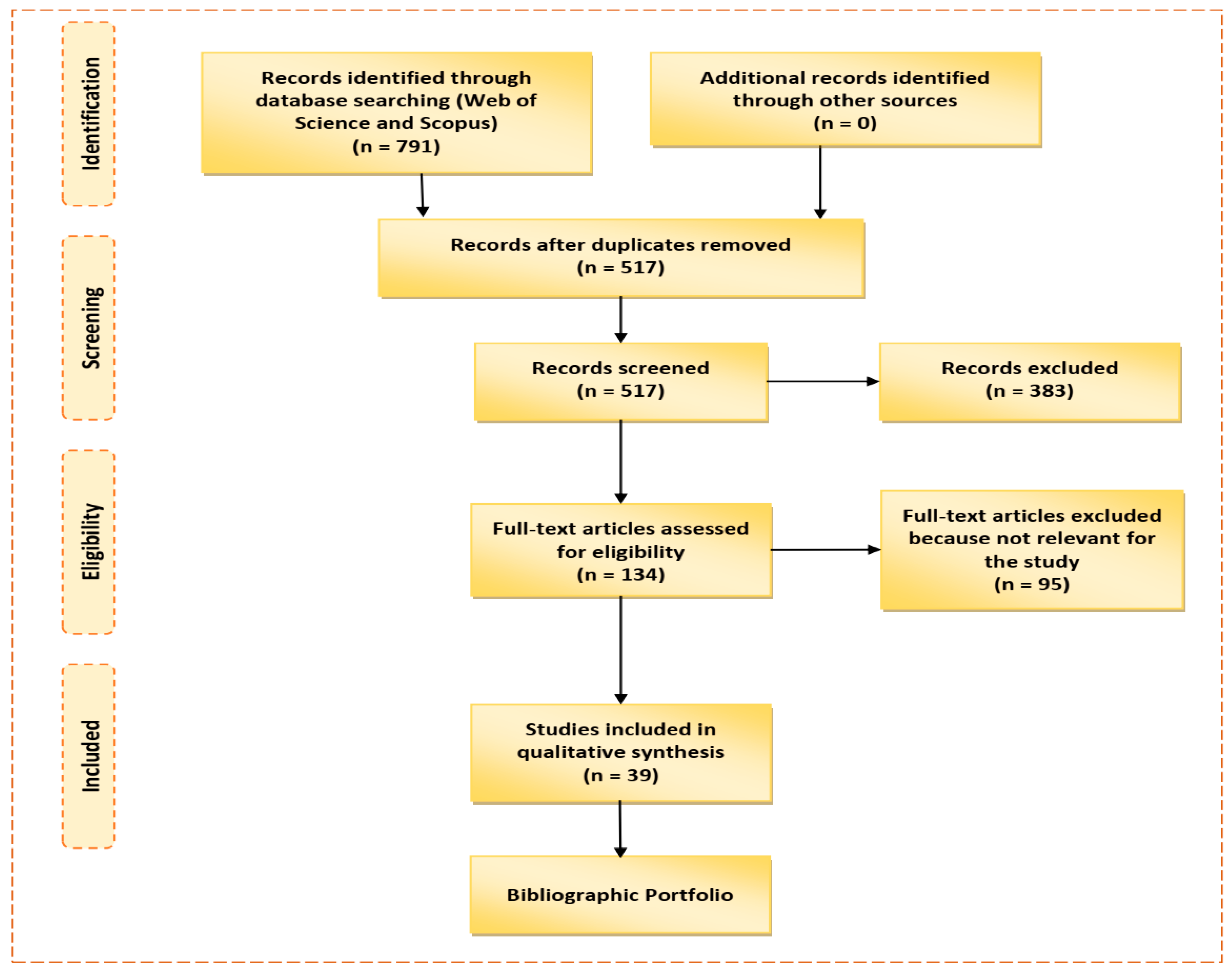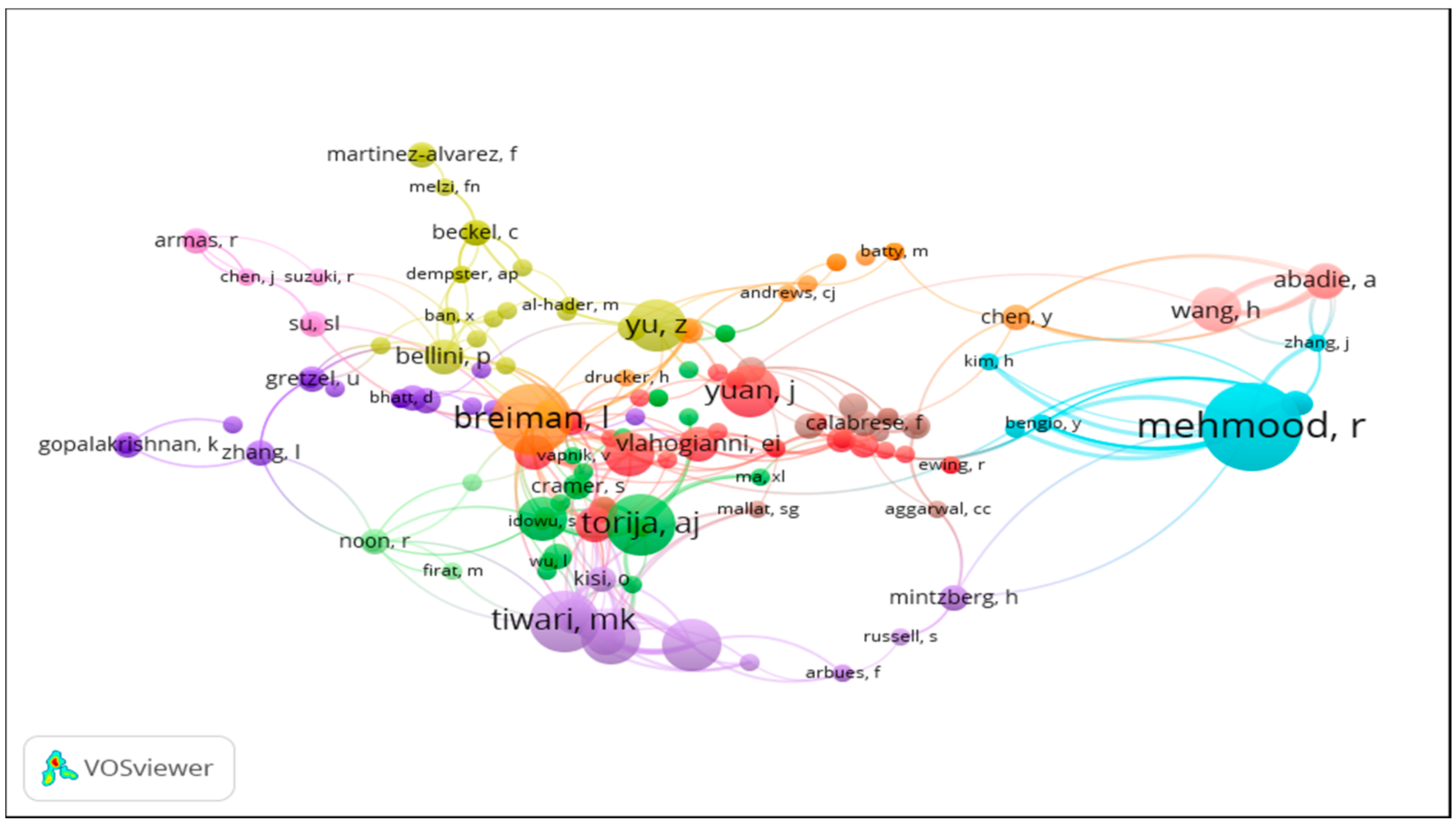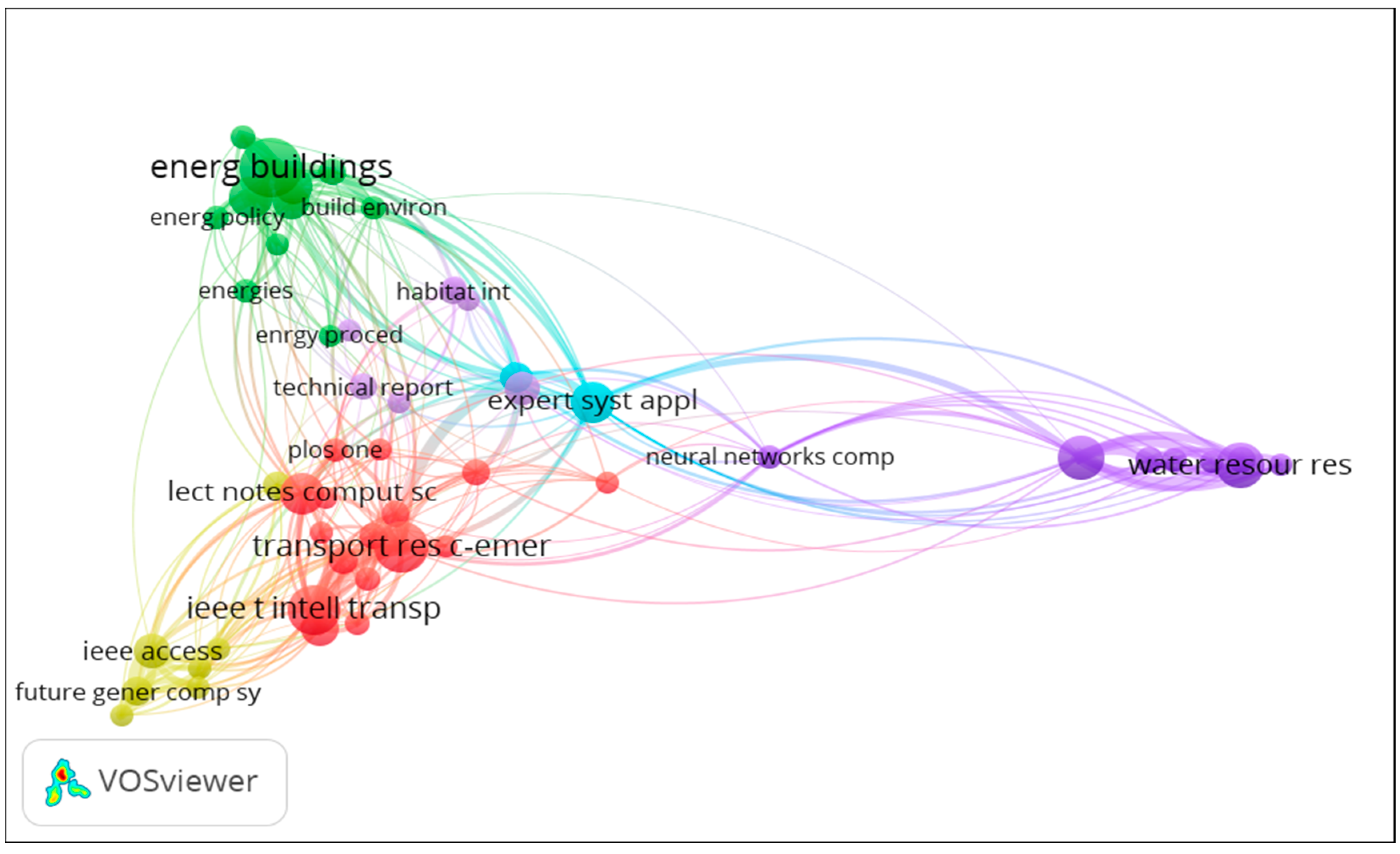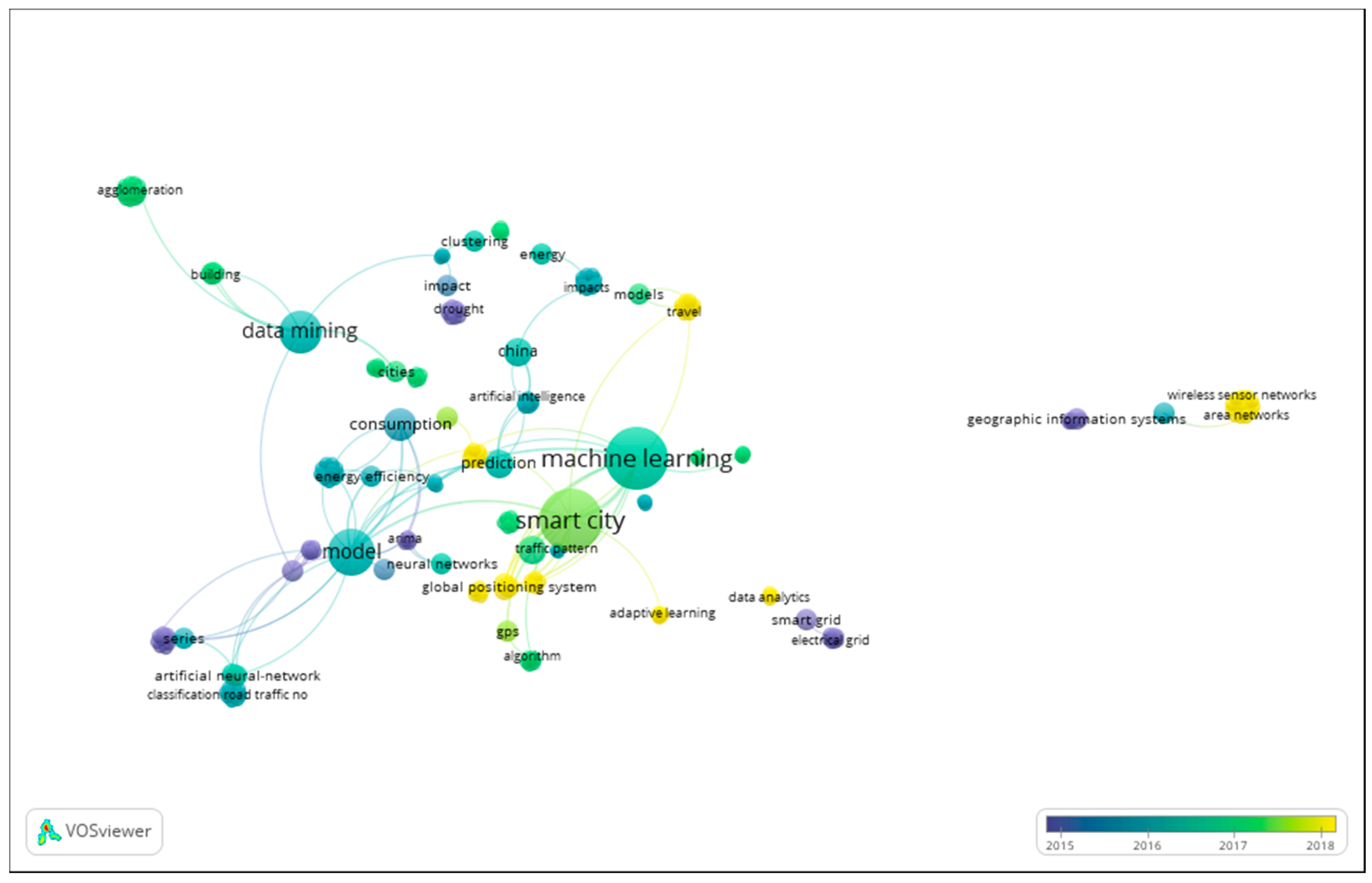Data Mining and Machine Learning to Promote Smart Cities: A Systematic Review from 2000 to 2018
Abstract
1. Introduction
2. Materials and Methods
- RQ1. What are the most commonly used DM and ML techniques to promote smart cities?
- RQ2. What areas are most engaged in promoting smart cities?
- Group 1: “Smart city,” “smart cities,” “smart community,” “smart communities,” “intelligent city,” “intelligent cities,” “sustainable city,” “sustainable cities,” “knowledge city,” “knowledge cities.”
- Group 2: “Data mining,” “machine learning,” “predictive analysis,” “descriptive analytics,” and “deep learning.”
3. Results and Discussion
3.1. Bibliographic Portfolio
3.2. Network Analysis
4. Conclusions
Author Contributions
Funding
Conflicts of Interest
References
- United Nations. World Urbanization Prospects: The 2018 Revision. 2018. Available online: https://esa.un.org/unpd/wup/Publications/Files/WUP2018-KeyFacts.pdf (accessed on 26 November 2018).
- Bibri, S.E.; Krogstie, J. Smart sustainable cities of the future: An extensive interdisciplinary literature review. Sustain. Cities Soc. 2017, 31, 183–212. [Google Scholar] [CrossRef]
- Mattoni, B.; Gugliermetti, F.; Bisegna, F. A multilevel method to assess and design the renovation and integration of Smart Cities. Sustain. Cities Soc. 2015, 15, 105–119. [Google Scholar] [CrossRef]
- Pinheiro, E.; de Francisco, A.C.; Piekarski, C.M.; de Souza, J.T. How to identify opportunities for improvement in the use of reverse logistics in clothing industries? A case study in a Brazilian cluster. J. Clean. Prod. 2019, 210, 612–619. [Google Scholar] [CrossRef]
- Novotný, R.; Kuchta, R.K.J. Smart City Concept, Applications and Services. J. Telecommun. Syst. Manag. 2014, 3, 1. [Google Scholar]
- Myeong, S.; Jung, Y.; Lee, E. A Study on Determinant Factors in Smart City Development: An Analytic Hierarchy Process Analysis. Sustainability 2018, 10, 2606. [Google Scholar] [CrossRef]
- Albino, V.; Berardi, U.; Dangelico, R. Smart Cities: Definitions, Dimensions, Performance, and Initiatives. J. Urban Technol. 2015, 22, 3–21. [Google Scholar] [CrossRef]
- Abella, A.; Ortiz-de-Urbina-Criado, M.; De-Pablos-Heredero, C. A model for the analysis of data-driven innovation and value generation in smart cities’ ecosystems. Cities 2017, 64, 47–53. [Google Scholar] [CrossRef]
- Marsal-Llacuna, M.-L.; Colomer-Llinàs, J.; Meléndez-Frigola, J. Lessons in urban monitoring taken from sustainable and livable cities to better address the Smart Cities initiative. Technol. Forecast. Soc. Chang. 2015, 90, 611–622. [Google Scholar] [CrossRef]
- Giffinger, R.; Fertner, C.; Kramar, H.; Kalasek, R.; Milanović, N.; Meijers, E. Smart Cities—Ranking of European Medium-Sized Cities; Vienna UT: Wien, Austria, 2007. [Google Scholar]
- Iker, Z.; Alessandro, S.; Saioa, A. Smart City Concept: What It Is and What It Should Be. J. Urban Plan. Dev. 2016, 142, 4015005. [Google Scholar]
- Wu, Y.; Zhang, W.; Shen, J.; Mo, Z.; Peng, Y. Smart city with Chinese characteristics against the background of big data: Idea, action and risk. J. Clean. Prod. 2018, 173, 60–66. [Google Scholar] [CrossRef]
- Lim, C.; Kim, K.-J.; Maglio, P.P. Smart cities with big data: Reference models, challenges, and considerations. Cities 2018, 82, 86–99. [Google Scholar] [CrossRef]
- Honarvar, A.R.; Sami, A. Towards Sustainable Smart City by Particulate Matter Prediction Using Urban Big Data, Excluding Expensive Air Pollution Infrastructures. Big Data Res. 2018. [Google Scholar] [CrossRef]
- Wenge, R.; Zhang, X.; Dave, C.; Chao, L.; Hao, S. Smart city architecture: A technology guide for implementation and design challenges. China Commun. 2014, 11, 56–69. [Google Scholar] [CrossRef]
- Kitchin, R. The real-time city? Big data and smart urbanism. GeoJournal 2014, 79, 1–14. [Google Scholar] [CrossRef]
- Rousseau, D.M. The Oxford Handbook of Evidence-Based Management; Oxford University Press: Oxford, UK, 2012; ISBN 9780199763986. [Google Scholar]
- ten Ham-Baloyi, W.; Jordan, P. Systematic review as a research method in post-graduate nursing education. Heal. SA Gesondheid 2016, 21, 120–128. [Google Scholar] [CrossRef]
- Barros, M.V.; Piekarski, C.M.; de Francisco, A.C. Carbon Footprint of Electricity Generation in Brazil: An Analysis of the 2016–2026 Period. Energies 2018, 11, 1412. [Google Scholar] [CrossRef]
- Pagani, R.; Kovaleski, J.; Resende, L. Methodi Ordinatio: A proposed methodology to select and rank relevant scientific papers encompassing the impact factor, number of citation, and year of publication. Scientometrics 2015, 104, 1–27. [Google Scholar] [CrossRef]
- van Eck, N.J.; Waltman, L. Software survey: VOSviewer, a computer program for bibliometric mapping. Scientometrics 2010, 84, 523–538. [Google Scholar] [CrossRef]
- Yuan, J.; Zheng, Y.; Xie, X.; Sun, G. T-Drive: Enhancing Driving Directions with Taxi Drivers’ Intelligence. IEEE Trans. Knowl. Data Eng. 2013, 25, 220–232. [Google Scholar] [CrossRef]
- Rudin, C.; Waltz, D.; Anderson, R.; Boulanger, A.; Salleb-Aouissi, A.; Chow, M.; Dutta, H.; Gross, P.; Huang, B.; Ierome, S.; et al. Machine learning for the New York City power grid. IEEE Trans. Pattern Anal. Mach. Intell. 2012, 34, 328–345. [Google Scholar] [CrossRef]
- Jurado, S.; Nebot, A.; Mugica, F.; Avellana, N. Hybrid methodologies for electricity load forecasting: Entropy-based feature selection with machine learning and soft computing techniques. Energy 2015, 86, 276–291. [Google Scholar] [CrossRef]
- Pérez-Chacón, R.; Luna-Romera, J.M.; Troncoso, A.; Martínez-Alvarez, F.; Riquelme, J.C. Big data analytics for discovering electricity consumption patterns in smart cities. Energies 2018, 11, 683. [Google Scholar] [CrossRef]
- Peña, M.; Biscarri, F.; Guerrero, J.I.; Monedero, I.; León, C. Rule-based system to detect energy efficiency anomalies in smart buildings, a data mining approach. Expert Syst. Appl. 2016, 56, 242–255. [Google Scholar] [CrossRef]
- Liu, L.; Silva, E.A.; Wu, C.; Wang, H. A machine learning-based method for the large-scale evaluation of the qualities of the urban environment. Comput. Environ. Urban Syst. 2017, 65, 113–125. [Google Scholar] [CrossRef]
- Muhammed, T.; Mehmood, R.; Albeshri, A.; Katib, I. UbeHealth: A Personalized Ubiquitous Cloud and Edge-Enabled Networked Healthcare System for Smart Cities. IEEE Access 2018, 6, 32258–32285. [Google Scholar] [CrossRef]
- Massana, J.; Pous, C.; Melendez, J.; Colomer, J. Identifying services for short-term load forecasting using data driven models in a Smart City platform. Sustain. Cities Soc. 2017, 28, 108–117. [Google Scholar] [CrossRef]
- Wang, X.; Li, Z.; Meng, H.; Wu, J. Identification of key energy efficiency drivers through global city benchmarking: A data driven approach. Appl. Energy 2017, 190, 18–28. [Google Scholar] [CrossRef]
- Abbasi, M.; El Hanandeh, A. Forecasting municipal solid waste generation using artificial intelligence modelling approaches. Waste Manag. 2016, 56, 13–22. [Google Scholar] [CrossRef]
- Badii, C.; Nesi, P.; Paoli, I. Predicting Available Parking Slots on Critical and Regular Services by Exploiting a Range of Open Data. IEEE Access 2018, 6, 44059–44071. [Google Scholar] [CrossRef]
- Madu, C.N.; Kuei, C.; Lee, P. Urban sustainability management: A deep learning perspective. Sustain. Cities Soc. 2017, 30, 1–17. [Google Scholar] [CrossRef]
- Gomede, E.; Gaffo, F.H.; Brigano, G.U.; de Barros, R.M.; de Mendes, L.S. Application of Computational Intelligence to Improve Education in Smart Cities. Sensors 2018, 18, 267. [Google Scholar] [CrossRef] [PubMed]
- Cramer, S.; Kampouridis, M.; Freitas, A.A.; Alexandridis, A.K. An extensive evaluation of seven machine learning methods for rainfall prediction in weather derivatives. Expert Syst. Appl. 2017, 85, 169–181. [Google Scholar] [CrossRef]
- You, H.; Yang, X. Urban expansion in 30 megacities of China: Categorizing the driving force profiles to inform the urbanization policy. Land Use Policy 2017, 68, 531–551. [Google Scholar] [CrossRef]
- Nagy, A.M.; Simon, V. Survey on traffic prediction in smart cities. Pervasive Mob. Comput. 2018, 50, 148–163. [Google Scholar] [CrossRef]
- Belhajem, I.; Ben Maissa, Y.; Tamtaoui, A. Improving Vehicle Localization in a Smart City with Low Cost Sensor Networks and Support Vector Machines. Mob. Netw. Appl. 2018, 23, 854–863. [Google Scholar] [CrossRef]
- Fernández-Ares, A.; Mora, A.M.; Arenas, M.G.; García-Sanchez, P.; Romero, G.; Rivas, V.; Castillo, P.A.; Merelo, J.J.; Fernandez-Ares, A.; Mora, A.M.; et al. Studying real traffic and mobility scenarios for a Smart City using a new monitoring and tracking system. Future Gener. Comput. Syst. 2017, 76, 163–179. [Google Scholar] [CrossRef]
- Belhajem, I.; Ben Maissa, Y.; Tamtaoui, A. Improving low cost sensor based vehicle positioning with Machine Learning. Control Eng. Pract. 2018, 74, 168–176. [Google Scholar] [CrossRef]
- Gopalakrishnan, K. Deep Learning in Data-Driven Pavement Image Analysis and Automated Distress Detection: A Review. Data 2018, 3, 28. [Google Scholar] [CrossRef]
- Khan, M.S.; Woo, M.; Nam, K.; Chathoth, P.K. Smart City and Smart Tourism: A Case of Dubai. Sustainability 2017, 9, 2279. [Google Scholar] [CrossRef]
- Idowu, S.; Saguna, S.; Ahlund, C.; Schelen, O. Applied machine learning: Forecasting heat load in district heating system. Energy Build. 2016, 133, 478–488. [Google Scholar] [CrossRef]
- Bellini, P.; Cenni, D.; Nesi, P.; Paoli, I. Wi-Fi based city users’ behaviour analysis for smart city. J. Vis. Lang. Comput. 2017, 42, 31–45. [Google Scholar] [CrossRef]
- Tiwari, M.K.; Adamowski, J.F. Medium-Term Urban Water Demand Forecasting with Limited Data Using an Ensemble Wavelet-Bootstrap Machine-Learning Approach. J. Water Resour. Plan. Manag. 2015, 141, 04014053. [Google Scholar] [CrossRef]
- Melzi, F.N.; Same, A.; Zayani, M.H.; Oukhellou, L. A Dedicated Mixture Model for Clustering Smart Meter Data: Identification and Analysis of Electricity Consumption Behaviors. Energies 2017, 10, 1446. [Google Scholar] [CrossRef]
- Brentan, B.M.; Meirelles, G.; Herrera, M.; Luvizotto, E., Jr.; Izquierdo, J. Correlation Analysis of Water Demand and Predictive Variables for Short-Term Forecasting Models. Math. Probl. Eng. 2017. [Google Scholar] [CrossRef]
- Kwoczek, S.; Di Martino, S.; Nejdl, W. Predicting and visualizing traffic congestion in the presence of planned special events. J. Vis. Lang. Comput. 2014, 25, 973–980. [Google Scholar] [CrossRef]
- Torija, A.J.; Ruiz, D.P. Automated classification of urban locations for environmental noise impact assessment on the basis of road-traffic content. Expert Syst. Appl. 2016, 53, 1–13. [Google Scholar] [CrossRef]
- Armas, R.; Aguirre, H.; Daolio, F.; Tanaka, K. Evolutionary design optimization of traffic signals applied to Quito city. PLoS ONE 2017, 12. [Google Scholar] [CrossRef] [PubMed]
- Zhang, N.; Chen, H.; Chen, X.; Chen, J. Forecasting Public Transit Use by Crowdsensing and Semantic Trajectory Mining: Case Studies. ISPRS Int. J. Geo-Inf. 2016, 5, 180. [Google Scholar] [CrossRef]
- Del Busto Pinzon, D.F.; de Souza, F.T. A data based model as a metropolitan management tool: The Bogota-Sabana region case study in Colombia. Land Use Policy 2016, 54, 253–263. [Google Scholar] [CrossRef]
- Zheng, Y.; Zheng, H.; Ye, X. Using Machine Learning in Environmental Tax Reform Assessment for Sustainable Development: A Case Study of Hubei Province, China. Sustainability 2016, 8, 1124. [Google Scholar] [CrossRef]
- Pinelli, F.; Calabrese, F.; Bouillet, E. A Methodology for Denoising and Generating Bus Infrastructure Data. IEEE Trans. Intell. Transp. Syst. 2015, 16, 1042–1047. [Google Scholar] [CrossRef]
- Liu, Y.; Zhao, J.; Wang, Z. Identifying determinants of urban water use using data mining approach. Urban Water J. 2015, 12, 618–630. [Google Scholar] [CrossRef]
- Kuang, W.; An, S.; Jiang, H. Detecting Traffic Anomalies in Urban Areas Using Taxi GPS Data. Math. Probl. Eng. 2015. [Google Scholar] [CrossRef]
- Kosmides, P.; Adamopoulou, E.; Demestichas, K.; Theologou, M.; Anagnostou, M.; Rouskas, A. Socially Aware Heterogeneous Wireless Networks. Sensors 2015, 15, 13705–13724. [Google Scholar] [CrossRef] [PubMed]
- Liu, S.; Chen, L.; Ni, L.M. Anomaly Detection from Incomplete Data. ACM Trans. Knowl. Discov. Data 2014, 9. [Google Scholar] [CrossRef]
- Wang, Y.; Zou, Z. Spatial Decision Support System for Urban Planning: Case Study of Harbin City in China. J. Urban Plan. Dev. 2010, 136, 147–153. [Google Scholar] [CrossRef]
- Zhuang, P.; Shang, Y.; Hua, B. Statistical methods to estimate vehicle count using traffic cameras. Multidimens. Syst. Signal Process. 2009, 20, 121–133. [Google Scholar] [CrossRef]
- Visvizi, A.; Lytras, M.D.; Damiani, E.; Mathkour, H. Policy making for smart cities: Innovation and social inclusive economic growth for sustainability. J. Sci. Technol. Policy Manag. 2018, 9, 126–133. [Google Scholar] [CrossRef]
- Jin, Y.; Cao, W.; Wu, M.; Yuan, Y. Accurate fuzzy predictive models through complexity reduction based on decision of needed fuzzy rules. Neurocomputing 2019, 323, 344–351. [Google Scholar] [CrossRef]
- Al Nuaimi, E.; Al Neyadi, H.; Mohamed, N.; Al-Jaroodi, J. Applications of big data to smart cities. J. Internet Serv. Appl. 2015, 6, 25. [Google Scholar] [CrossRef]
- Lytras, M.; Raghavan, V.; Damiani, E. Big Data and Data Analytics Research:: From Metaphors to Value Space for Collective Wisdom in Human Decision Making and Smart Machines. Int. J. Semant. Web Inf. Syst. 2017, 13, 1–10. [Google Scholar] [CrossRef]
- Lytras, M.; Aljohani, N.; Hussain, A.; Luo, J.; Xi Zhang, J. Cognitive Computing Track Chairs’ Welcome & Organization. In Proceedings of the The Web Conference 2018, Lyon, France, 23–27 April 2018; pp. 247–250. [Google Scholar]
- Tang, M.; Liao, H.; Wan, Z.; Herrera-Viedma, E.; Rosen, M.A. Ten Years of Sustainability (2009 to 2018): A Bibliometric Overview. Sustainability 2018, 10, 1655. [Google Scholar] [CrossRef]
- Li, H.; An, H.; Wang, Y.; Huang, J.; Gao, X. Evolutionary features of academic articles co-keyword network and keywords co-occurrence network: Based on two-mode affiliation network. Phys. A Stat. Mech. Its Appl. 2016, 450, 657–669. [Google Scholar] [CrossRef]
- Liao, H.; Tang, M.; Luo, L.; Li, C.; Chiclana, F.; Zeng, X.-J. A Bibliometric Analysis and Visualization of Medical Big Data Research. Sustainability 2018, 10, 166. [Google Scholar] [CrossRef]
- Gu, D.; Li, J.; Li, X.; Liang, C. Visualizing the knowledge structure and evolution of big data research in healthcare informatics. Int. J. Med. Inform. 2017, 98, 22–32. [Google Scholar] [CrossRef] [PubMed]
- Tollefson, J. China declared world’s largest producer of scientific articles. Nature 2018, 553, 390. [Google Scholar] [CrossRef] [PubMed]




| Combination of Keywords | Databases | Total | |
|---|---|---|---|
| Web of Science | Scopus | ||
| Group 1 AND Group 2 | 333 search results (143 articles, 187 conference paper, and 6 editorial) | 458 search results (200 articles, 226 conference papers, and 32 book chapters) | 791 |
| Authors | Year | Title |
|---|---|---|
| Yuan et al. [22] | 2013 | T-Drive: Enhancing Driving Directions with Taxi Drivers’ Intelligence |
| Rudin et al. [23] | 2012 | Machine Learning for the New York City Power Grid |
| Jurado et al. [24] | 2015 | Hybrid methodologies for electricity load forecasting: Entropy-based feature selection with machine learning and soft computing techniques |
| Pérez-Chacón et al. [25] | 2018 | Big data analytics for discovering electricity consumption patterns in smart cities |
| Peña et al. [26] | 2016 | Rule-based system to detect energy efficiency anomalies in smart buildings, a data mining approach |
| Liu et al. [27] | 2017 | A machine learning-based method for the large-scale evaluation of the qualities of the urban environment |
| Muhammed et al. [28] | 2018 | UbeHealth: A Personalized Ubiquitous Cloud and Edge-Enabled Networked Healthcare System for Smart Cities |
| Massana et al. [29] | 2017 | Identifying services for short-term load forecasting using data driven models in a Smart city platform |
| Wang et al. [30] | 2017 | Identification of key energy efficiency drivers through global city benchmarking: a data driven approach |
| Abbasi and El Hanandeh [31] | 2016 | Forecasting municipal solid waste generation using artificial intelligence modelling approaches |
| Badii et al. [32] | 2018 | Predicting Available Parking Slots on Critical and Regular Services by Exploiting a Range of Open Data |
| Madu et al. [33] | 2017 | Urban sustainability management: A deep learning perspective |
| Gomede et al. [34] | 2018 | Application of Computational Intelligence to Improve Education in Smart Cities. |
| Cramer et al. [35] | 2017 | An extensive evaluation of seven machine learning methods for rainfall prediction in weather derivatives |
| You and Yang [36] | 2017 | Urban expansion in 30 megacities of China: categorizing the driving force profiles to inform the urbanization policy |
| Nagy and Simon [37] | 2018 | Survey on traffic prediction in smart cities |
| Belhajem et al. [38] | 2018 | Improving Vehicle Localization in a Smart City with Low Cost Sensor Networks and Support Vector Machines |
| Fernández-Ares et al. [39] | 2017 | Studying real traffic and mobility scenarios for a Smart City using a new monitoring and tracking system |
| Belhajem et al. [40] | 2018 | Improving low cost sensor based vehicle positioning with Machine Learning |
| Gopalakrishnan [41] | 2018 | Deep Learning in Data-Driven Pavement Image Analysis and Automated Distress Detection: A Review |
| Khan et al. [42] | 2017 | Smart City and Smart Tourism: A Case of Dubai |
| Idowu et al. [43] | 2016 | Applied machine learning: Forecasting heat load in district heating system |
| Bellini et al. [44] | 2017 | Wi-Fi based city users’ behaviour analysis for smart city |
| Tiwari and Adamowski [45] | 2015 | Medium-Term Urban Water Demand Forecasting with Limited Data Using an Ensemble Wavelet-Bootstrap Machine-Learning Approach |
| Melzi et al. [46] | 2017 | A Dedicated Mixture Model for Clustering Smart Meter Data: Identification and Analysis of Electricity Consumption Behaviors |
| Brentan et al. [47] | 2017 | Correlation Analysis of Water Demand and Predictive Variables for Short-Term Forecasting Models |
| Kwoczek et al. [48] | 2014 | Predicting and visualizing traffic congestion in the presence of planned special events |
| Torija and Ruiz [49] | 2016 | Automated classification of urban locations for environmental noise impact assessment on the basis of road-traffic content |
| Armas et al. [50] | 2017 | Evolutionary design optimization of traffic signals applied to Quito city |
| Zhang et al. [51] | 2016 | Forecasting Public Transit Use by Crowdsensing and Semantic Trajectory Mining: Case Studies |
| Del Busto Pinzon and Souza [52] | 2016 | A data based model as a metropolitan management tool: The Bogotá-Sabana region case study in Colombia |
| Zheng et al. [53] | 2016 | Using Machine Learning in Environmental Tax Reform Assessment for Sustainable Development: A Case Study of Hubei Province, China |
| Pinelli et al. [54] | 2015 | A Methodology for Denoising and Generating Bus Infrastructure Data |
| Liu et al. [55] | 2015 | Identifying determinants of urban water use using data mining approach |
| Kuang and Jiang [56] | 2014 | Detecting Traffic Anomalies in Urban Areas Using Taxi GPS Data |
| Kosmides et al. [57] | 2015 | Socially Aware Heterogeneous Wireless Networks |
| Liu et al. [58] | 2014 | Anomaly detection from incomplete data |
| Wang and Zou [59] | 2010 | Spatial Decision Support System for Urban Planning: Case Study of Harbin City in China |
| Zhuang et al. [60] | 2009 | Statistical methods to estimate vehicle count using traffic cameras |
© 2019 by the authors. Licensee MDPI, Basel, Switzerland. This article is an open access article distributed under the terms and conditions of the Creative Commons Attribution (CC BY) license (http://creativecommons.org/licenses/by/4.0/).
Share and Cite
Souza, J.T.d.; Francisco, A.C.d.; Piekarski, C.M.; Prado, G.F.d. Data Mining and Machine Learning to Promote Smart Cities: A Systematic Review from 2000 to 2018. Sustainability 2019, 11, 1077. https://doi.org/10.3390/su11041077
Souza JTd, Francisco ACd, Piekarski CM, Prado GFd. Data Mining and Machine Learning to Promote Smart Cities: A Systematic Review from 2000 to 2018. Sustainability. 2019; 11(4):1077. https://doi.org/10.3390/su11041077
Chicago/Turabian StyleSouza, Jovani Taveira de, Antonio Carlos de Francisco, Cassiano Moro Piekarski, and Guilherme Francisco do Prado. 2019. "Data Mining and Machine Learning to Promote Smart Cities: A Systematic Review from 2000 to 2018" Sustainability 11, no. 4: 1077. https://doi.org/10.3390/su11041077
APA StyleSouza, J. T. d., Francisco, A. C. d., Piekarski, C. M., & Prado, G. F. d. (2019). Data Mining and Machine Learning to Promote Smart Cities: A Systematic Review from 2000 to 2018. Sustainability, 11(4), 1077. https://doi.org/10.3390/su11041077





